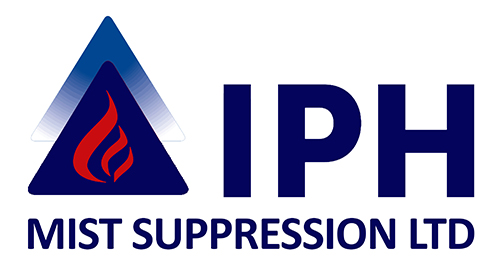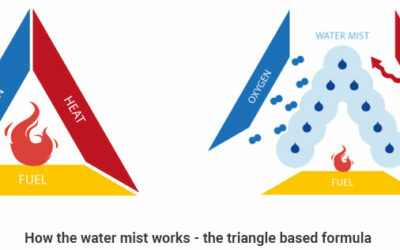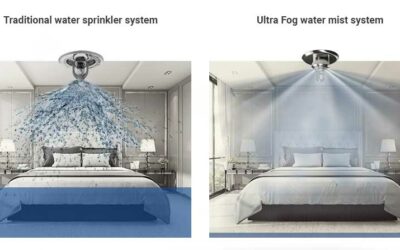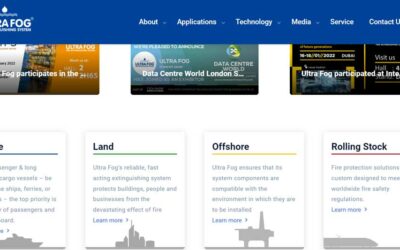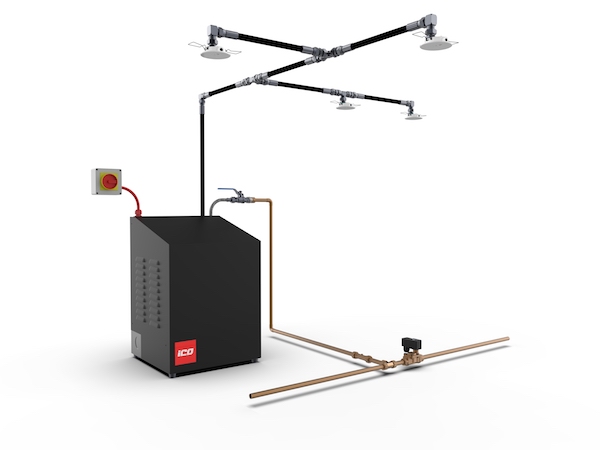For a long time, there has not been a British Standard for the commercial water mist system, which those in the fire safety community can use. The lack of British Standards for water mist fire protection to date had been seen by some to have provided a ‘cowboy culture’ in the marketplace.
However, the publication of BS8458 covering the domestic and residential use of water mist; and the BS8489 series covering the industrial and commercial application of water mist fire protection is seen as a major step forward in this regard.
BS:8489
The New British Standard
We give you the facts for the new commercial water mist fire protection standard:
The factual information provided here has been sourced from:
Bob Whitely Chairman, FSH18/5 and FIA/BAFSA
Water Mist Working Group
Fire Industry Association (FIA)
Published 2016: source LINK
Why British Standards for mist?
The work in the European standards body, CEN, has only produced a Technical Specification document which cannot be considered a standard.
Also, the UK industry took the view that the CEN agenda did not address UK needs and concerns.
The development of BS8489 and BS8458
The water mist standard began life in 2006 as a Draft for Development – DD8489. This, as the name implies, created a provisional standard to allow information and experience to be obtained.
Two expert groups were then formed to use industry best practice and who, through team efforts, has created BS8458 and the BS8489 series to reflect industry the current knowledge and experience.
The BSI Water mist Working Group
The Working Group, FSH18/5, was formed from representatives from FSH18/2 (sprinklers) and FSH18/6 (gases) fire committees, plus representatives from the Fire Industry Association (FIA), the British Automatic Fire Sprinkler Association (BAFSA), UK Insurers, the Loss Prevention Council (LPC) and Factory Mutual (FM).
FSH18/5 formed three working groups to work on:
- BS8458 the domestic and residential standard for water mist;
- BS8489 series for industrial and commercial water mist;
- Input to CEN TS14972.
This article will now focus on the key elements of BS8489 Part 1, covering system design and installation.
BS8489 – principle requirements – testing
Specific areas within the building can be protected by water mist where relevant fire test protocols exist. The test protocols must be representative of actual conditions, thus:
- Similar fuel
- Comparable compartment volume
- Compartment height is comparable
- Similar ventilation conditions.
In some instances, these have been carried out in-house by water mist suppliers. However, it is highly desirable for independent third parties to carry out the testing and certification. The test facilities are expected to operate a quality system with water mist in their scope of accreditation. The test protocol should be recognised and/or agreed by all interested parties. The laboratory test record should be published showing what equipment and systems have demonstrated performance and listing the equipment and components for their intended application.
The successful test results/ test report would include details of components and parameters used in tests; maximum and minimum nozzles heights and spacing; and minimum flows and pressures to be met or exceeded. These would then be incorporated into manufacturer’s design manual to replicate the system as tested.
These requirements, in themselves, represent a major step forward in providing the information needed for decision makers to make an informed choice regarding the use of water mist and those suppliers with the necessary capabilities. BS8489 principle requirements – Protection.
BS8489 principle requirements – Protection
Water mist systems may be engineered to provide either local application or volume protection with design parameters established by representative fire tests.
Local Application: extinguishing systems designed for object protection with design parameters established by representative fire tests. This enables protection of discrete hazard objects within a larger, and possibly, unprotected enclosure.
Volume Protection: (either via open nozzles or automatic, frangible bulb operated nozzles) are systems designed for hazards within a volume i.e. creating a protected enclosure. Depending upon the application and testing, the systems may be designed to provide fire suppression of ordinary combustibles or fire extinguishment of flammable liquid fires.
BS8489 principle requirements – duration
Extinguishing systems are required to operate for twice the duration to extinguish and prevent re-ignition as established by the test. For suppression systems the requirements are:
- To suit hazard with 60 minutes minimum.
- For automatic nozzle systems, the maximum flow must be based upon the most favourable ‘Assumed Maximum Area of Operation’ (AMAO).
- System piping must be fully hydraulically designed.
BS8489 principle requirements – components
Components should be in accordance with LPS1283/FM5560 or equivalent.
Nozzles should be made of corrosion resistant materials and be permanently marked. Open nozzles should incorporate blockage prevention devices, and automatic nozzles have thermal release elements per BSEN12259-1 quick response.
Piping materials are expected to be stainless steel, copper, or in certain cases galvanised steel with additional protective measures.
BS8489 principle requirements – water supplies
Water supplies must be capable of supplying both the hydraulically most unfavourable AND the most favourable AMAOs with wholesome/demineralised/ deionised/ sweet industrial water from:
- Towns main.
- One or more automatic starting pump sets.
- One or more pressurised cylinders.
The supplies must provide continuity and reliability of supply. Where other than 100% capacity pump suction tanks are used they must have an effective capacity of at least 30% of full capacity AND the infill rate is sufficient to meet discharge duration requirements, and it can be tested to verify performance.
Dedicated pump houses are required to be constructed with 60-minute fire resistance if forming a separate building, but 120 minutes if adjacent to or within a water mist protected building.
Pump houses need to include:
- Permanent pump flow/pressure test facility.
- Pump driver power 110% of rated power demand.
- Pump continuous flow to prevent overheating.
- Pump suction strainer.
Where multiple pumps are deployed to deliver the required flows and pressures they need to include:
- Common suction.
- Individual pump isolation.
- Sequence starting.
- Starting to ensure sustained system pressure.
Water supplies using dedicated cylinders must have permanent means to check pressure and water content.
BS8489 principle requirements – Annexes
The standard includes four annexes:
- Elements of typical water mist systems – shows typical configurations of pump and tank, pump and towns main, cylinders commonly used for water mist fire systems.
- Sets out the provisions where enhanced availability is needed for volume protection systems.
- Provides informative text and diagrams explaining how assumed maximum areas of operation are determined.
- Sets out the testing requirements for water mist nozzles.
Fire test protocols
Four fire test protocols have been included, as part of the BS8489 series as protocols which will be of general interest and value, however, other, third-party accredited protocols may be used with this standard.
Part 4 – For the protection of local applications.
Part 5 – For the protection of combustion turbines and machinery spaces ≤ 80 m3.
Part 6 – For the protection of industrial oil cookers.
Part 7 –for the protection of low hazard occupancies.
Summary:
BS8489 and its sister standard BS8458 provide, for the first time in the UK marketplace, a series of standards which reflect the best industry practices for water mist fire engineering. They will assist specifiers, users and fire protection companies ensuring that water mist is used effectively and appropriately where the technology is viable and has been validated.
IPH Mist Suppression of course adhere to this standard when designing, installing and servicing commercial water mist systems throughout the UK.
